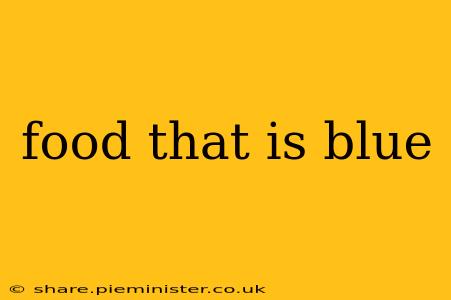Blue food. It's not the most common color on our plates, is it? While reds, greens, and yellows abound, blue foods often feel a bit… exotic. But the reality is that this surprisingly rare hue boasts a fascinating array of culinary delights, from naturally occurring pigments to clever food science. Let's dive into the world of blue food and explore its captivating nuances.
What Foods Are Naturally Blue?
Naturally occurring blue pigments in food are relatively rare. Many foods we perceive as blue actually contain other pigments that appear blue under certain lighting conditions or due to our perception. That being said, here are some truly blue foods:
-
Blueberries: These tiny powerhouses are arguably the most well-known blue food. Their deep, vibrant hue comes from anthocyanins, potent antioxidants associated with numerous health benefits. The intensity of the blue can vary depending on the variety and ripeness of the berry.
-
Blue Corn: This ancient grain, cultivated by indigenous peoples in the Americas for centuries, produces a striking blue masa flour, perfect for tortillas, tamales, and even blue corn chips. Its blue color, again, comes from anthocyanins.
-
Butterfly Pea Flower: This vibrant blue flower, popular in Southeast Asian cuisine, is used to create stunningly colored teas and drinks. The color changes depending on the pH level, turning purple or pink when an acid like lemon juice is added.
What Foods Appear Blue, But Aren't Naturally So?
Many foods achieve a blue hue through artificial coloring or clever culinary techniques. While natural blue pigments are scarce, our desire for visually appealing food has led to some creative solutions:
-
Blue Curaçao: This liqueur, known for its brilliant blue color, is not naturally blue. Its characteristic hue is achieved through artificial coloring. It is frequently used in cocktails like the Blue Lagoon.
-
Blue Candy and Sweets: Many candies and sweets achieve their blue shades through the use of artificial food coloring. While these are widely available, it's important to be aware of artificial additives and consume them in moderation.
-
Foods Colored with Spirulina: Spirulina, a blue-green algae, is a nutritional powerhouse, rich in protein and antioxidants. While often appearing greenish, it can be used to add a subtle blue tint to some foods and beverages.
Why are naturally blue foods so rare?
This is a fascinating question that delves into the chemistry of plant pigments. While red, yellow, and orange pigments are relatively common in plants, blue pigments are less frequent. The synthesis of blue pigments is more complex, requiring specific chemical structures and environmental conditions.
Are there any health benefits associated with eating blue foods?
The health benefits vary depending on the specific food. Blueberries, for example, are rich in antioxidants that may contribute to better heart health and improved cognitive function. Other blue foods, like blue corn, may also offer nutritional advantages depending on their preparation. However, it's crucial to remember that relying on the color of food alone for health benefits is misleading. A balanced diet rich in diverse fruits, vegetables, and grains is key.
How can I incorporate more blue foods into my diet?
Incorporating more blue foods into your diet can be easier than you think. Simply adding blueberries to your breakfast yogurt or oatmeal is a great start. Experimenting with blue corn tortillas or trying a Butterfly Pea Flower tea adds a vibrant touch and unique flavor to your meals. Remember to explore various recipes and find ways to creatively integrate these naturally beautiful foods.
In conclusion, the world of blue food is far more interesting than one might initially think. While naturally occurring blue pigments are rare, their presence and creative culinary uses contribute to a diverse and visually stunning culinary landscape. From the antioxidant power of blueberries to the vibrant hues of Butterfly Pea Flower tea, blue foods offer a unique and exciting addition to any diet.
